Drilling Technology
Teamwork and technology shift drilling performance paradigm
Total drilling time in a Wyoming field decreased to an average 83% of previous best-in-class performance in a counter-intuitive method applying slow motor speeds and sharp, fixed-cutter bit technology
Samantha Shepard, BP America Production Co.; Todd Hansen, Hunting Performance, Inc.; Michael Hooper, Dyna-Drill Technologies, Inc.; and Jim Elder, ReedHycalog, a Grant Prideco company
Improving penetration rates in Wyoming's Green River basin's Wamsutter field presented a difficult challenge that required innovative thinking, challenging paradigms and application of new technology. The result has been a momentous increase in rate of penetration (ROP) that improves field economics and increases the number of potential drilling candidates in this active region.
Slow drilling rates in the field's deeper formations were caused by laminated stringers of hard shale and soft bentonite. Unfortunately, the method for addressing bit-balling in the soft sections was counter to the method for optimizing ROP in the hard sections. The solution came in two steps.
The first step was a technique developed and recommended by the motor rental company, Hunting Performance. Its approach was a counter-intuitive method that involved reducing bit rpm to increase ROP. The application of a slow-rpm motor power section was key to this advance. The second step was application of bit technology using new, wear-resistant cutters that allowed drilling to TD in a single run.
The result of these innovations is that nearly half of the Wamsutter wells are drilled with total times less than the benchmark best-in-class that existed before the technology shift.
DRILLING BACKGROUND
Wamsutter field comprises seven areas distinguished by slight variations in drilling characteristics. Each area is assigned a drilling benchmark for “best-in-class” that is defined as the total days per 10,000 ft. Days per 10,000 ft (d/10k) is a normalization of total dry-hole days to a 10,000-ft reference point – an attempt to take the time variation due to depth out of the equation. The benchmark includes drilling hours, circulating hours, trip time and unplanned events. The 2001 benchmark (as of December 2001) forms the basis of comparison for all improvements discussed in this article.
The main reservoir target is the Almond formation. Found at about 9,000 ft to 12,000 ft, it comprises marginal marine sands/ mudstones in the upper and middle sections, and fluvial river deposits with shales and coals in the lower section. Production is from very tight, gas-bearing sands (0.01 mD permeability) that are fracture stimulated.
Above the Almond is the 2,100-ft-thick Lewis shale that begins at about 7,000 ft to 9,000 ft. It is made up of marine shale with submarine fan sandstone deposits that are often gas bearing. These hard shales are layered with bentonite clays that are a source of bit-balling problems. Together, this ratty sequence of shales and clays caused slow penetration rates and limited the footage that could be drilled in a single run below the surface hole.
Successful PDC bit runs from surface hole to top of the Almond were made in the softer Wamsutter areas in early 1999. Most of these runs were on 0.34 revolution per gallon (rpg), high-torque mud motors. PDC bits with 19-mm cutters and six blades were being run in most of these vertical wells.
Slow penetration rates, typically 2 fph to 3 fph, were encountered in the deeper Lance, Fox Hills and Lewis formations. It was initially assumed that the cause was bit-balling in the bentonite stringers. This was indicated by a drop in motor differential pressure and string torque, and a slower penetration rate.
The slow-downs were treated by running light bit weights, high flowrates, nut plug sweeps, SAPP sweeps and pumping soap sticks. These efforts were largely unsuccessful. After further investigation, it was determined that bit-balling coincided with low motor differential pressure (MDP) – less than 50 psi. The treatments were more effective when accompanied by a 50- to 100-psi MDP increase.
Hard stringers caused slow penetration rates that were accompanied by higher MDP. To address this condition, a different set of parameters was required. In a departure from the conventional drilling wisdom that, to increase ROP, you must increase bit weight and rotate faster, it was found that slow bit speeds yielded the best penetration rates. Bit rpm was slowed by reducing flowrate and rotary table rpm, and weight-on-bit was added until an acceptable penetration rate was reached.
This method was successful in increasing penetration rates to 10 fph from 2 – 3 fph. It was determined that slowing bit speed and adding weight caused the PDC cutters to bury themselves into formation more effectively, thereby improving penetration rates.
However, bringing flowrates down to the 330- to 350-gpm range in these hard streaks was very detrimental to bit cooling and cleaning, and resulted in PDC heat-check damage that caused the cutters to fail.
This slow-rpm drilling method was employed with varying degrees of success. Several wells were drilled with one bit from surface hole to TD, but these wells were drilled in softer areas. Attempts to use off-the-shelf, slower-speed/ low-torque motors were unsuccessful due to motor stalling with PDC torque. In the tougher areas of the field, reaching the top of the Almond with a single bit run still posed problems. The challenge of drilling to TD everywhere in the field with one bit required a solution that was different from the answers provided by conventional motors.
A NEW APPROACH – PHASE I: SLOW-SPEED MOTORS
Based on limited success drilling with slower-rpm conventional motors, the low-speed, high-flow capabilities of the Hunting Performance mud motor with the ESX power section were of particular interest. After much discussion about departing from the conventional wisdom, the drilling team decided to try the ESX power section. The first commercial power section was 6-3/4 -in. diameter with a 7:8 lobe count, 2.1 stage, and 0.13 rpg.
The application in 2002 of an extra-slow speed, extended-length (ESX) power section from Dyna-Drill Technologies provided a means to reduce rpm and still maintain the higher flowrates needed to cool the bit and prevent balling. The new 0.13- and 0.16-rpg ESX power sections also provided higher torque than was previously available with the 0.28- and 0.34-rpg power sections.
The power section was originally developed in the late 1990s for very slow motor drilling with rock bits in hard formations. The design also considered the needs of PDC bits, which were drilling in increasingly hard rock. Roller cone bits need slow speed, but not high torque; PDC bits, running at any speed, require high torque. To address the different applications, specs for the power section were set for both features – very low speed and very high torque, Fig. 1.
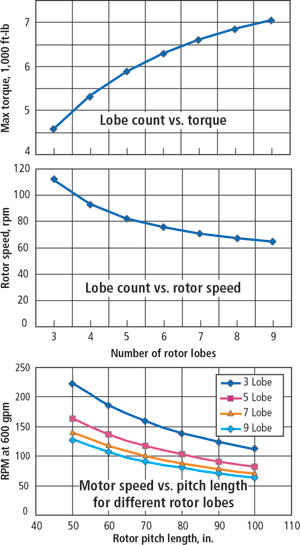 |
Fig. 1. Relationship of: lobe count and torque output; lobe count and rotor speed; and motor speed and pitch length for four rotor lobe counts.
|
|
In designing power sections, it is well known that increasing lobe count of rotor and stator proportionally slows down and increases torque output of a drilling motor. What is often overlooked in determining power section speed is the pitch (or stage) length. Lengthening the pitch lowers revolutions per gallon (rpg). Curves in Fig. 1 compare design parameters with a 6-3/4 -in. motor envelope, 230-in. long with a 600-gpm flow. These specs anticipated the dual requirements that were later determined to increase ROP in Wamsutter drilling.
In the shallower, softer formations above the Lewis shale, rotary table speed was increased to compensate for the slower speed motor. As the deeper, firmer formations were encountered, rotary table rpm was slowed and weight on bit was adjusted in an effort to keep motor differential pressure in the 250- to 300-psi range. To minimize bit damage, drillers were instructed to avoid bit bounce or excessive torque, and to stay within operating ranges of bit weight and rotary table speed. They had the freedom to adjust parameters within these ranges.
This approach of rotating slower to drill faster had the anticipated results. Penetration rates in the upper hole were slightly slower with the 0.16-rpg motor than with a 0.34-rpg motor, but in the deeper, firmer formations, penetration rates were significantly higher. Dull bit condition was also much better when using the slow-speed motor.
With this success, slow-speed motors were applied throughout the field. In virtually all cases, penetration rates were significantly increased in the lower hole. The motor also reduced heat-check damage to the PDC cutters due to reduced speed and an ability to maintain flowrates in the 400- to 425-gpm range.
Another benefit of using the slow-speed power section was control. Rotating speed became a parameter that can be effectively adjusted on the rig floor to optimize drilling performance in specific conditions – adjusting table rpm has little effect with 0.34-rpg motors. These slow-speed capabilities resulted in the routine ability to make single-bit runs to the top of the Almond, including harder areas of the field.
The improvements made with the ESX motor on offset wells are illustrated in Fig. 2. The 0.34-rpg motor drilled from surface hole to the top of the Almond formation in 7.2 days with an average ROP of 48.2 fph. The 0.16-rpg motor drilled the same section of the hole (with the same bit type) in 5.9 days with an average ROP of 60.2 fph (a 25% increase in ROP) with most of the benefit coming in the last 1,000 ft of drilling. Overall, 45% of the wells drilled in 2002 using the slow-rpm method were drilled faster than the 2001 best-in-class.
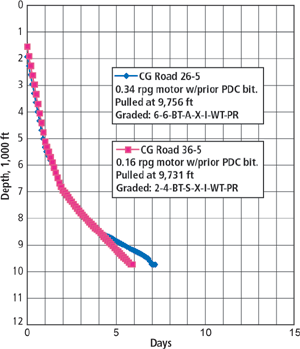 |
Fig. 2. Daily depth chart, 0.34 revolutions per gallon (rpg) vs. 0.16 rpg (ESX) motor.
|
|
The challenge remained to reach TD in one run.
PHASE II: IMPROVED BIT TECHNOLOGY
The next step in improving drilling performance was to extend the bit run from the top of the Almond to TD. This required an improvement in bit technology.
In 2002, a new type of ReedHycalog fixed cutter technology was being used by BP drilling groups in the Arkoma and Tuscaloosa formations of South Texas. Extremely sharp and wear resistant, the patented thermostable TReX synthetic diamond cutter technology, Fig. 3, was yielding impressive ROP and footage increases in a variety of hard rock applications.
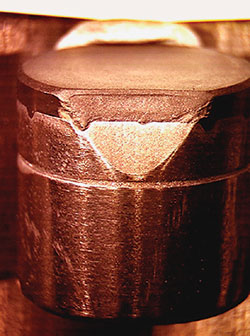 |
Fig. 3. Close-up of TReX cutter.
|
|
In the Arkoma, BP was successfully drilling Red Oak, Panola and Brazil Sands with UCS ranges of 15,000 psi to 35,000 psi on medium-speed, bent-housing motors. This allowed the elimination of numerous roller cone insert runs and increased the ROP.
Studying bit technology for Wamsutter. As experience was gained with the new cutters, ReedHycalog representatives studied the performances of PDC bits, and the slow-speed motors in Wamsutter. A five-blade, 16-mm cutter DSX210 bit design was specified based on several considerations: 1) prior runs with competitive bits generally used six-blade designs. In other applications, the high abrasion resistance of the new cutters had allowed a more aggressive design; and 2) increased open-faced volume provided improved bit cleaning in support of higher penetration rates.
And, in areas of the field where the Almond is encountered at a shallower depth, a number of unconsolidated shales, coals and clays are found near TD. The open, lighter-set bit would be less susceptible to balling and would improve the effectiveness of applied WOB.
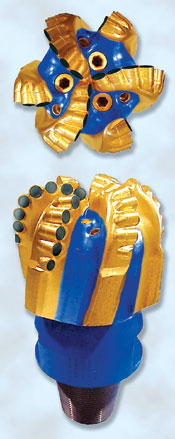 |
Fig. 4. Two views of the six-blade DSX199 bit that made significant ROP increases with slow-speed motors.
|
|
Successful slow-speed, six-blade bit application. The new bit technology was used with the slow-speed method to drill one of the shallower Almond areas of the field. The run was successful in both the resulting ROP and the ability to reach TD. After examining the dull bits from the first runs, it was decided to test a six-blade DSX199 design, Fig. 4, to address inconsistent impact damage indicative of bit whirl and drillstring vibration. This decision was based on the following considerations:
- Total cutter count for the six-blade design is similar to the DSX210 five-blade design. Changing to the six-blade design provided comparable cutter point loading with little added WOB.
- The extra blade provided additional circumferential stability to help maintain cutting structure integrity and reduce or minimize impact damage.
- The open-face volume was a concern to be monitored through testing.
And, considering the objective of drilling all Wamsutter wells consistently with one bit run, the six-blade design provided increased durability without sacrificing ROP in drilling the deeper, more consolidated Almond sections.
“Staggering” performance improvements. Changing to the DSX199 resulted in successful drilling performance, with the bit reaching TD the vast majority of the time. Penetration rates averaged 60 – 90 fph for the entire run, depending on well depth and Almond formation durability.
The footage improvement compared to direct offset wells is illustrated in Fig. 5. The prior bit drilled from surface hole to TD in 6.6 days with an average ROP of 54.6 fph, including a trip at 9,491 ft. The six-blade bit drilled the same section in 3.9 days with an average ROP of 93.5 fph, a 71% increase, with most of the benefit coming in the last 3,000 ft of drilling, and through elimination of a bit trip.
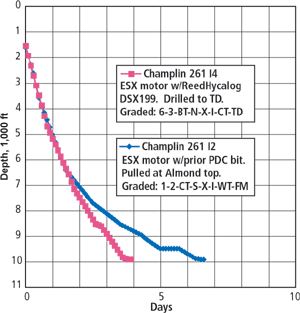 |
Fig. 5. Daily depth chart shows reduced drilling days of DSX199 bit vs. prior bit, both with slow-speed ESX motor.
|
|
Combining these two technologies resulted in staggering performance improvements. A full 80% of the 2003 wells beat the 2001 best-in-class performance in the field. Average total well times were 17% faster than the best-in-class performance just 1-1/2 years earlier.
The DSX199 is now the standard bit for drilling in the field, with the DSX210 being used in the shallowest parts of the field. Testing and modifications of drilling parameters are currently focused on vibration control and cutting structure developments.
CONCLUSION
Innovative thinking and application of new technology significantly improved penetration rates in Wamsutter field. The counter-intuitive method of reducing bit rpm to increase ROP initiated a steady improvement in penetration rates.
In 2003, the addition of TReX cutters further improved drilling performance, allowing a majority of wells to be drilled in a single bit run from the surface hole.
Fig. 6 represents each well drilled from January 2002 to July 2003, and compares it to the best-in-class. If the well exactly matched the best-in-class, it equals 1.0; wells drilled faster than best-in-class are <1.0 and those drilled slower are >1.0. The magnitude of the number represents the percent of actual drilling time compared to the best-in-class time.
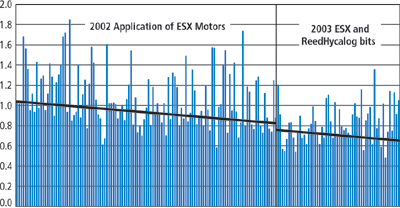 |
Fig. 6. Performance history in Wamsutter wells, compared to best-in-class wells to December 2001 benchmark (1.0 value), for application of ESX motors (2002), and ESX plus six-blade bits (2003). Overall trend is indicated by the heavy line.
|
|
Achievements of this motor-bit application are the result of drilling engineer, drilling foremen, service provider and product manufacturers engaging in an open exchange of ideas. Implementation of the changes was controlled and incremental, and occurred in an environment where thinking outside the box was encouraged. It was understood that conventional equipment and technologies were no longer acceptable.
Slow-rpm, high-torque motors with PDC bits are now the norm in the Wamsutter area and the technology is spreading to other areas where conditions require an innovative set of drilling parameters. 
THE AUTHORS
|
 |
Samantha Shepard, wells superintendent in the GOM shelf for BP America Production Co., earned a BS in petroleum engineering at Texas A&M University in 1989. She was with Conoco for five years before joining Amoco, and has worked in a variety of engineering/ drilling supervisor roles. She has 15 years international/ domestic experience in the onshore/ offshore oil/ gas industry.
|
 |
Todd Hansen, an independent consultant providing well site supervision through Wickersham Consulting Inc. His 22 years in the drilling industry include employment with Smith International; Drilex Systems, Inc.; Diamond Products International; Security Div. of Halliburton; and Hunting Performance.
|
 |
Michael Hooper, vice president of Dyna-Drill Technologies, Inc., earned a BSME from Long Beach State University. He has 15 years experience as a project engineer in bit design, eight years as a product development manager for motors and LWD systems, and five years in manufacturing management. Mr. Hooper holds eight US patents and is a member of SPE, SME, ASM and ASME.
|
 |
Jim Elder, senior account manager for ReedHycalog, graduated from Eastern Illinois University with a BS in Earth Sciences. He joined the company in 1979, and has provided customer support for over 24 years in North and South America.
|
|












